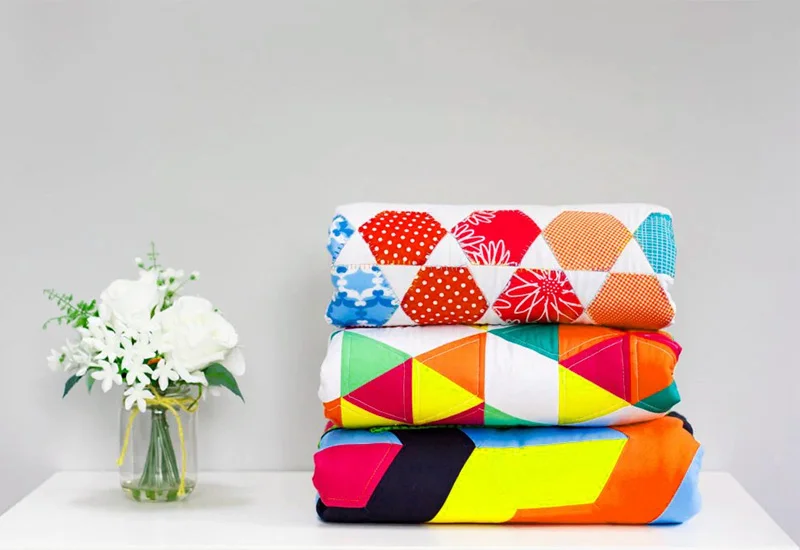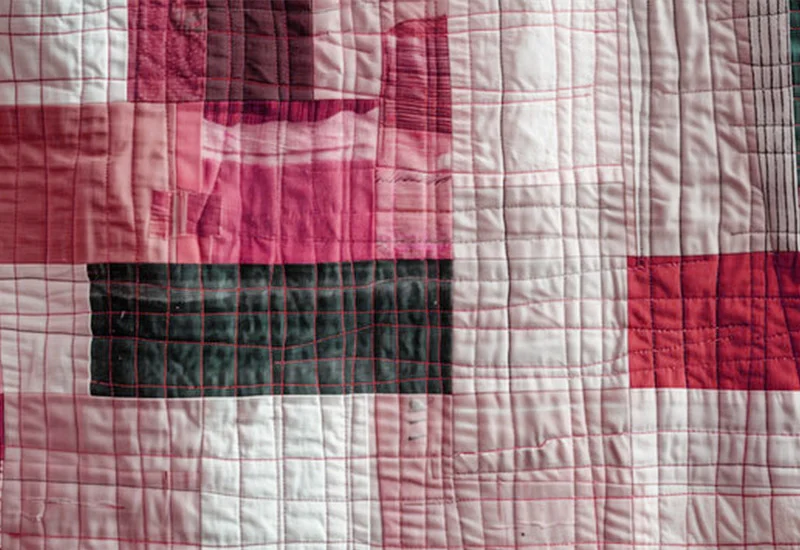
Patchwork and quilting are two terms that often get mixed up, what is the difference between patchwork and quilting? Whether you’re a beginner or a seasoned quilter, understanding these two distinct techniques can make a big difference in your projects.
What is Patchwork?

Patchwork refers to the technique of sewing together small pieces of fabric to create a larger design. It is primarily a decorative process, and the beauty comes from how these fabric pieces, or patches, are arranged in creative patterns. The focus in patchwork is on assembling fabrics to make a unique top layer.
The Process of Patchwork
To create patchwork, you cut pieces of fabric in various shapes, often squares or triangles, and sew them together. The key is precision, ensuring each piece fits seamlessly with the others to form a cohesive pattern. Whether you choose a classic block design like a “Nine Patch” or a more intricate style like a “Star Block,” patchwork is about piecing together a colorful top layer.
Popular Patterns in Patchwork
Patchwork allows for endless creativity. Some popular designs include the Log Cabin, Flying Geese, and Pinwheel patterns. The variety of fabric choices and arrangements makes each piece personal and unique.
What is Quilting?

Quilting is the technique that binds the patchwork top to a backing fabric with batting (the middle layer). This process adds texture and durability to the finished piece. Unlike patchwork, quilting serves both functional and decorative purposes. The quilting stitches can be simple straight lines or elaborate patterns that enhance the overall design.
The Quilting Process
The quilting process begins after the patchwork top is completed. A quilt sandwich is created by layering the patchwork, batting, and backing. Once layered, quilting stitches are applied to keep the layers together. The choice of quilting style—whether hand quilting, machine quilting, or longarm quilting—depends on personal preference and the project.
Types of Quilting Stitches
There are various quilting styles, ranging from traditional hand-stitched designs to machine quilting. Common types of stitches include straight-line quilting, echo quilting, and the more complex free-motion quilting. These stitches not only hold the layers together but also add texture and dimension to the quilt.
Key Differences Between Patchwork and Quilting

Although patchwork and quilting are often seen together in a single quilt, they play very different roles. Below is a deeper comparison of these two techniques to help clarify their unique functions in quilt-making.
Patchwork is Decorative, While Quilting Adds Functionality
Patchwork is mainly about design. In patchwork, different fabric pieces—usually in geometric shapes like squares, triangles, or hexagons—are sewn together to create a visually appealing top layer. The arrangement of these pieces can form intricate patterns or simple, repetitive blocks. Some of the most popular patchwork patterns include Log Cabin, Flying Geese, and Hexagon.
In contrast, quilting serves a functional purpose. Quilting involves stitching through all layers of the quilt (the patchwork top, the batting, and the backing) to hold them together. This not only adds durability but also provides warmth and texture. The stitching can be simple or elaborate, with some quilters creating complex free-motion designs that add to the overall aesthetics of the quilt.
Patchwork Comes First, Quilting is the Final Touch
Patchwork is usually the first step in making a quilt. The individual fabric pieces are carefully arranged and sewn together to form the quilt top. Once this top layer is complete, quilting is the final step. The quilting stitches not only bind the top layer to the batting and backing but also provide the quilt with its finished look and durability.
In other words, the patchwork defines the visual identity of the quilt, while quilting enhances both the appearance and structure.
Patchwork Focuses on Design, Quilting Adds Texture
Patchwork’s primary focus is on color and pattern design. This technique allows for endless creativity through the use of different fabrics. A well-designed patchwork can become a piece of art in itself, with each fabric chosen for its color, texture, or pattern. Quilters often enjoy the challenge of blending or contrasting fabrics to create a harmonious or dynamic look.
On the other hand, quilting adds a layer of dimension and texture to the flat patchwork design. The quilting stitches give the quilt a 3D effect, as they create raised and recessed areas. This gives the quilt a tactile quality, making it more than just a visual piece.
Patchwork vs Quilting: Tools and Techniques
The tools used for patchwork are often different from those used for quilting. For patchwork, you’ll need a rotary cutter, rulers, and a sewing machine (or needle and thread if you’re doing it by hand). Precision is key, so quilters take extra care in cutting and piecing fabric to ensure all pieces fit together perfectly.
For quilting, the main tools include quilting needles, a walking foot or free-motion foot for your sewing machine, and possibly a quilting hoop if you’re hand-quilting. While patchwork requires careful measurements, quilting often focuses on creative stitching that adds detail to the quilt.
The Role of Quilting in Enhancing Patchwork Designs
While quilting serves the functional purpose of keeping the layers together, it also has a decorative role. The type of quilting chosen can elevate the patchwork design. For example, a simple grid quilting pattern may give a clean, modern look, while intricate free-motion quilting can add a touch of artistry. The stitching lines often follow patchwork shapes, outlining blocks and patterns, or they can move in completely independent directions to create a secondary design element.
Summary of Key Differences:
| Feature | Patchwork | Quilting |
|---|---|---|
| Focus | Decorative design | Functional and decorative stitching |
| Timing | First step in quilt-making | Last step, after patchwork is done |
| Purpose | Create the top layer design | Bind layers together, add texture |
| Tools | Fabric, rotary cutter, sewing machine | Quilting needles, batting, backing |
| Creative Aspect | Choosing fabrics and arranging patterns | Adding dimension through stitches |
In summary, patchwork and quilting may be two sides of the same coin, but each plays a vital role in creating a beautiful and functional quilt. Understanding these key differences will allow you to appreciate the craft and improve your quilt-making skills.
How Patchwork and Quilting Work Together
In most quilts, patchwork and quilting are combined. The patchwork is created first to form the top layer, followed by the quilting that adds texture and structure. Together, they make a quilt that is both beautiful and practical.
A Creative Duo
Many quilters love the combination of patchwork and quilting because it allows for endless possibilities. Patchwork offers creative freedom in terms of color and pattern, while quilting enhances the texture and durability. The finished piece is often a reflection of personal style and skill.
FAQs
What is the difference between patchwork and quilting?
Patchwork is the process of sewing small pieces of fabric together to create a decorative top layer. Quilting, on the other hand, involves stitching this patchwork layer to a backing and batting to add texture and durability. Patchwork focuses on design, while quilting adds structure and functionality.
Can I make a quilt without patchwork?
Yes, you can make a quilt without patchwork. You can use a single piece of fabric for the top layer (called a “whole cloth quilt”) and then quilt it by adding stitches through the batting and backing.
What materials do I need for the patchwork?
For patchwork, you’ll need fabric pieces (often cotton), a rotary cutter or scissors, a sewing machine or needle and thread, and rulers for precision. Optional tools include cutting mats and fabric markers.
Conclusion
While patchwork and quilting are related, they serve different functions in the creation of a quilt. Patchwork is about design and creativity, while quilting adds structure and durability. Understanding the difference between the two can help you appreciate the craft more and improve your own projects.
